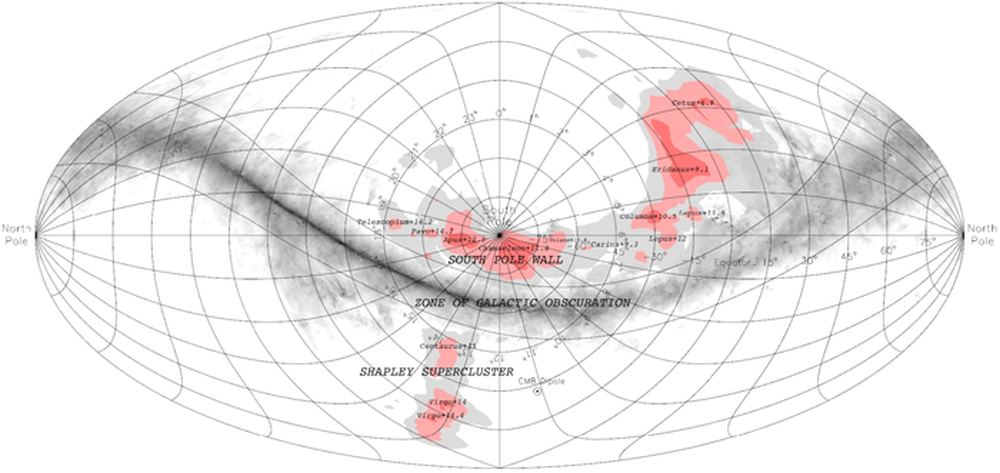
Galaxies are not evenly distributed throughout space. They exist in groups, groups, and superclusters. Our own galaxy, the Milky Way, exists in an incredibly vast structure called the Laniakea supercluster. Laniakea was defined in 2014 and contains more than 100,000 galaxies.
Now, a team of astronomers has discovered another huge feature beyond Laniakea, called the South Pole wall.
The wall of the South Pole is like an arm that surrounds the Laniakea supercluster. The name is inspired by the south pole of the Earth. In that direction, the wall is thicker.
The Wall arches in a large semicircle that covers 200 degrees and reaches the northern sky. The concentration in the direction of the south pole is 500 million light years away, and the extended arm of the Wall to the north is 300 million light years away.
“We have found it thanks to its gravitational influence, imprinted on the speeds of a sample of galaxies.”
Daniel Pomarède, cosmic cartographer and scientist on the staff of the Research Institute for Fundamental Laws of the Universe.
A team of astronomers has spent a decade mapping the wall of the South Pole. They have presented their results in a document entitled “Cosmicflows-3: The South Pole Wall. “The main author is Daniel Pomarède, staff scientist at the Institute for Research on Fundamental Laws of the Universe, CEA Université Paris-Saclay. Pomarède is also an expert in astronomical data visualization and cosmography.
The article is published in The Astrophysical Journal.

For such a large structure, the South Pole Wall has gone unnoticed for quite some time. In a press release, lead author Daniel Pomarède explained why. “One might wonder how such a large and not so distant structure went unnoticed. This is due to its location in a region of the sky that has not been fully studied, and where direct observations are hampered by patches of dust and galactic clouds in the foreground. We have found it thanks to its gravitational influence, imprinted on the speeds of a sample of galaxies. “
Study author Daniel Pomarède is an expert in astronomical data visualization. In this study, he created an interactive 3D model of the South Pole Wall.

The South Pole wall is just the latest large-scale cosmic structure that astronomers have mapped out in recent history. Over the past 40 years, we have come to understand that galaxies exist in large-scale clusters. Our own galaxy, the Milky Way, and its satellite galaxies are contained in a larger group of galaxies called the Local Group, a relatively small group of galaxies. The Local Group is in turn part of the Virgo Supercluster. And the Virgo Supercluster is just a lobe of the Laniakea supercluster.
Astronomers have also mapped out other massive features, such as the Shapley Supercluster and the Great Attractor, which is the central gravitational point of the Laniakea Supercluster.
Behind the discovery of the South Pole Wall is the Cosmicflows database. Cosmicflows tries to map structures on a large scale, gathering the positions and movements of thousands of galaxies. Cosmicflows-3 is the third iteration of the program and has expanded from 8,188 entries to 17,669 entries. Some of the researchers who wrote this article also worked on Cosmicflows-3.
“We wonder if the South Pole Wall is much bigger than what we see.”
R. Brent Tully, co-author of the study,
The galaxies in the arm are not static. There is a lot of movement. They move along the arm towards the South Pole. From there, they move through a region hidden from our view by the Milky Way. Then they move towards the Shapley connection, the largest structure in our neighborhood in the Universe.
The researchers are not sure if what they have mapped so far is the entire South Pole Wall. “We wonder if the South Pole Wall is much bigger than what we see,” said co-author R. Brent Tully. “What we have mapped extends to the entire domain of the region that we have surveyed. We are the first explorers of the cosmos, extending our maps into unknown territory, ”said Tully.

The discovery of the larger-scale structures of the Universe and the filamentary and agglomerated nature of things is one of the most interesting discoveries of recent times. Astronomers can identify these structures as their data improves and becomes more complete. Therefore, it is easy to ask how precise our current image is and what we still lack, what else is there to find.
In their article, the authors write “Observational limitations must be recognized.” They then explain that the South Pole Wall was found almost at the detection limits of the Cosmicflows-3 program. “The red shift limit of this contribution is 16,000 km sone. The South Pole Wall, as we constitute it, runs along a restricted line within this limit at ~ 13,000 km sone. “
So, the South Pole Wall is there, but it might not be all that is there.
“The proximity of Shapley’s concentration of rich clusters …” and other characteristics “… immediately north of the galactic plane raises the question of what we might be missing,” the authors write.
“Given the limitations imposed by the limits of our study, where does connectivity end?”
Of the paper “Cosmicflows-3: The wall of the South Pole ”
Although Cosmicflows-3 contains data on twice as many galaxies as its predecessor, it still cannot contain data on everything in the region. Each study and each method has its limitations. “Given the limitations imposed by the limits of our study, where does connectivity come from?
To be sure of the size of the South Pole Wall, and its relationship to other structures in the region, of course, they will require more data. “We will not be sure of its full scope, or whether it is unusual, until we map the universe on a significantly larger scale.”